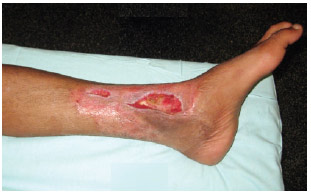ABSTRACT
BACKGROUND: Fractures of the distal third of the leg, ankle, and foot frequently present with exposed bone, requiring specialized teams to accomplish skin coverage. These teams are often not readily available, which can prevent the standard treatment of extensive debridement, fracture fixation, and use of flaps, which is termed the "fix and flap" method.
METHODS: The author proposes a 2-stage treatment method for such cases: negative pressure is imposed during debridement and bone exposure by the orthopedic team, followed by the elective preparation of free flaps for definitive coverage. Five patients were treated with a total of 6 free flaps, including 1 latissimus dorsi muscle and 5 of anterolateral thigh flaps. There was 1 total flap loss. Thus, the success rate was 83.34%.
RESULTS: The patients had good outcomes with limb salvage, preserved function, and no osteomyelitis.
CONCLUSIONS: Negative-pressure wound therapy is an option for the emergency treatment of open fractures of the lower limb, allowing the survival of elective free flaps without resulting in impairment as a final outcome.
Keywords:
Leg bones. Leg injuries. Tissue transplantation. Surgical flaps.
RESUMO
INTRODUÇÃO: Traumas do terço distal da perna, do tornozelo e do pé cursam frequentemente com exposição óssea, demandando equipes especializadas para realizar a cobertura cutânea definitiva. Muitas vezes, essas equipes não estão prontamente disponíveis, o que pode impedir o tratamento padrão, que consiste em amplo desbridamento, fixação das fraturas e utilização de retalhos (fix and flap).
MÉTODO: Neste trabalho, o autor propõe tratamento em duas etapas, sendo a primeira a instituição de terapia por pressão negativa quando do desbridamento e exposição óssea pela equipe da ortopedia, seguida pela realização de retalhos livres para cobertura definitiva, de forma eletiva. Foram tratados 5 pacientes, com realização de 6 retalhos livres, sendo 1 do músculo grande dorsal e outros 5 da face ântero-lateral da coxa. Houve perda total de um retalho, com índice de sucesso de 83,34%.
RESULTADOS: Os pacientes apresentaram boa evolução, com salvamento do membro, função preservada, e sem osteomielite.
CONCLUSÕES: A terapia por pressão negativa é uma opção no tratamento de urgência das exposições ósseas do membro inferior, permitindo a realização de retalhos livres de forma eletiva, sem prejuízo no resultado final para o paciente.
Palavras-chave:
Ossos da perna. Traumatismos da perna. Transplante de tecidos. Retalhos cirúrgicos.

























